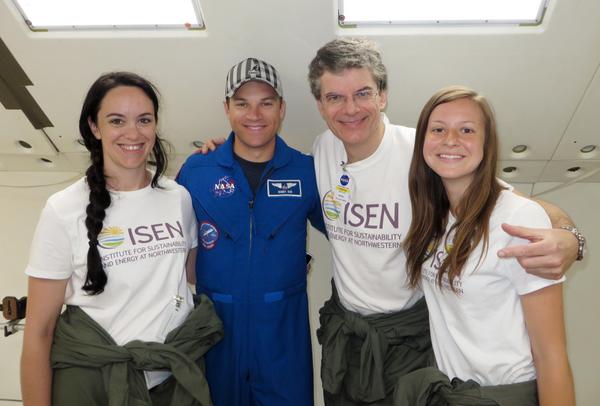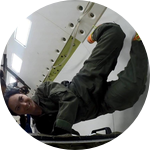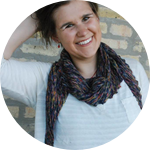About This Project
Freeze-casting is an environmentally friendly process used to fabricate porous materials. We are utilizing the freeze-casting technique in microgravity to improve overall efficiencies in dye-sensitized solar cells. Masking the force of Earth's gravity allows us to study the underlying principles of the technique. This offers a unique opportunity to improve the freeze-casting method for use on Earth!
Ask the Scientists
Join The DiscussionWhat is the context of this research?
The freeze-casting process is as easy as freezing water to make ice!
During periods of microgravity on parabolic flights, we place containers filled with titanium oxide particles suspended in water (slurry) on top of a very cold copper box. By only placing one side of the slurry container in contact with the freezing surface, we force the ice dendrites grow perpendicular to the freezing surface. As the dendrites grow, they push the titanium oxide particles out of the way, packing them into the spaces between the dendrites. We keep the sample frozen for the rest of the flight and for the rest of our time at NASA. Once the samples reach our lab at Northwestern University, we remove the ice and are left with titanium oxide "foam" consisting of pores that replicate the ice dendrites.
What is the significance of this project?
We are the first group to test freezing of suspensions in microgravity. At first glance, this experiment seems deceptively simple. Freezing has been studied extensively in microgravity, especially with regard to metals, but we are the first group to test freezing of suspensions.
All aspects of freezing conditions influence how ice dendrites grow. Since ice dendrites serve as the template for pores in our product, it is really important to learn how to control and manipulate their growth.
Gravity is a pesky force when it comes to studying this process because it causes the particles to fall toward the freezing surface and introduces convective effects that mix and break the dendrites. Masking these forces allows us to figure out what is going on behind the scenes to improve the process.
What are the goals of the project?
We've tested our process on prior microgravity flights where we successfully created improved materials. Products had better pore alignment and much less 'messiness'. For solar cells, messiness is equivalent to poor efficiencies.
However, we still have more work to do. We will be freezing our samples under Martian, Lunar and Asteroid gravity levels in addition to microgravity levels to increase our data points and improve our models.
Parabolic flights only allow 30 seconds of microgravity. Our main goal is to collect the data we need to send our research to the International Space Station where astronauts will run the experiment without the time constraint giving us larger samples and much more information to improve terrestrial fabrication
Budget
Our research is supported by grants from the following institutions:
Institute of Sustainability and Energy at Northwestern (ISEN)
NASA Flight Opportunities Program
Illinois Space Grant Consortium
Northwestern University Office of Undergraduate Research
As a result of the generous donations from our supporters, we're only $2,700 away from achieving the funding necessary to complete this phase of the project. Should this project be funded, we will be able to collect the data we need to prepare for experimental flight on the International Space Station, where we'll be granted the opportunity to learn more about the fundamental processes at work in order to improve terrestrial fabrication while also demonstrating freeze-casting as a space-based manufacturing technique!
Please visit our website at SpaceIce.org for more information about our work!
Endorsed by
Meet the Team
Team Bio
Collectively, the research team has over 1,200 parabolas of microgravity research experience!
Kristen Scotti is an undergraduate, Jack Kent Cooke Scholar at Northwestern, a 2011 NASA Aerospace Scholar, 2012 NASA Reduced Gravity Program selectee, a 2012 and 2014 Illinois Space Grant recipient, and the 2015 Clinton Global Initiative campus representative at NU.
Emily Northard is an environmental engineering undergraduate at Northwestern, the Communications Chair and Eco-Rep for GREEN House, and a member of the Clean Energy Project. Emily recently traveled to Iceland to conduct environmental engineering research!
Amelia Plunk, a graduate student in materials science at Northwestern, received her B.A. in physics from Mount Holyoke College, was named a 2013 NSF Research Fellow and spends her spare time working to increase the accessibility of science for LGBTQ-identified individuals.
Felicia Teller received her BA from Dartmouth College after receiving a Best Buy Children's Foundation scholarship and is currently a Post-Baccalaureate student at Northwestern.
The research team is advised by Dr. David Dunand, a world-renowned materials scientist. Dr. Dunand is the Co-Director of the Institute for Sustainability and Energy at Northwestern and the James N. and Margie M. Krebs Professor of Materials Science and Engineering at Northwestern University.
The research team is also grateful for the support of our collaborator from Los Alamos National Laboratory, Dr. Bryce Tappan.
Press and Media
Please visit our website at www.spaceice.org to learn more about our work!
You can read about our team's flight experience this past June in the Northwestern Life in Purple Blog. Our team was profiled in Northwestern University's Continuum Magazine.
The NASA's press release announcing our team's acceptance can be viewed here and our NASA Tech Portfolio can be viewed here.

Additional Information
Working in microgravity is a lot harder than it looks!
.jpg)
Project Backers
- 20Backers
- 45%Funded
- $1,215Total Donations
- $55.10Average Donation




